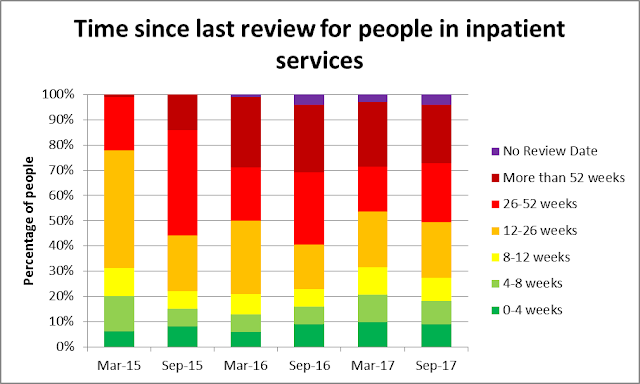This blogpost is the fourth of five looking at the Transforming
Care programme through the prism of the national statistics regularly produced
by the ever excellent @NHSDigital.
The first blogpost looked at the overall number of people
with learning disabilities and autistic people identified by the statistics as
being in inpatient services.
The second blogpost looked at statistics on the number of
people being admitted to inpatient services, and where they were being admitted
from.
The third blogpost looked at when people were in inpatient
units, how far were they from home and how long were they staying in inpatient
services.
This blogpost will focus on what the statistics are telling
us about planning within inpatient services, just using statistics from
Assuring Transformation. Even if Transforming Care is not yet showing big reductions
in the number of people in inpatient services, its effects should be felt
through the inpatient care plans people have, whether people’s needs are being
regularly reviewed, and whether people are having regular, effective Care and
Treatment Reviews (CTRs).
The first graph below shows the details of care plans for
people according to inpatient services, from March 2015 through to September
2017. By September 2017, almost a third of people (30%) were labelled ‘currently not
dischargeable because of level of behaviour that presents a risk to the person or others, or mental illness’, up nearly 10% from 21% in March 2015. The proportion of people
with an active treatment plan but no plan to leave has stayed pretty static
over time (39% of people). The proportion of people actively working towards a
plan to leave with a plan in place has dropped over time, from over a third
(35%) in March 2015 to just over a quarter (26%) in September 2017. Delayed
transfers of care are reported for relatively few people (4%) throughout. From
these figures, it is impossible to tell whether these changes are due to
changes in what inpatient services are doing, or changes in who is in inpatient
services.
For everyone in inpatient services, reviews should happen
regularly. The graph below shows how long ago people in inpatient services had
had their last review, from March 2015 to September 2017. The graph generally
shows that things seemed to get worse in 2016 but are improving again in 2017.
By September 2017, over a quarter of people (27%) had had a review in the past
12 weeks, and almost a further quarter (22%) between 12 weeks and 6 months ago.
However, almost another quarter (23%) last had a review between 6 months and
a year ago, and the final quarter 23% had last had a review over a year ago.
A particular form of review introduced by Transforming Care
as a way to bring independent voices in to challenge inpatient services is the
Care and Treatment Review (CTR). The graph below reports the last time people
in inpatient services had had a CTR, from October 2016 to September 2017. The
graph shows that the vast majority of people in inpatient services have had a
CTR at some point (85% of people in September 2017), and that this coverage has
increased from 70% of people in October 2016. Perhaps one concern is that 14%
of people last had a CTR more than a year ago, a proportion that has stayed
consistent over time.
What do CTRs recommend? Over the year from October 2016 to
September 2017, there were 2,050 CTRs for people in inpatient services. In well
over half of these (1,195 people; 58%) the conclusion was that the person was
not ready to leave and needed to be in an inpatient service. For almost a third
of people (655 people; 32%) the conclusion was that the person was ready to
have a plan to leave – for 240 of these 655 people there was no plan in place. For
a puzzling 160 people (8% of CTRs), an outcome was ‘not applicable’.
Overall there are signs that more people in inpatient
services are having both regular reviews and Care and Treatment Reviews. There
are still large numbers of people in inpatient services who have not had any
sort of review for a long time, however, and the proportion of people who
inpatient services are saying are ‘currently not dischargeable’ is increasing.
Update: This post has been updated to more accurately reflect the definition of 'currently not dischargeable' used in the statistics.
Update: This post has been updated to more accurately reflect the definition of 'currently not dischargeable' used in the statistics.




No comments:
Post a Comment
Note: only a member of this blog may post a comment.